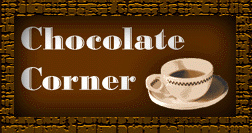1517 - The voyage which led Don Cortes to discover Mexico and the Aztec civilisation began in 1517 when he set sail from Cuba with 11 ships and 600 men, all seeking fame and fortune in the 'New World'. Landing on the Mexican coast near Veracruz, he decided to make his way to Tenochtitlan to see for himself the famed riches of Emperor Montezuma and the Aztec empire.
It was Montezuma who introduced Don Cortes to his favourite drink 'chocolatl' served in a golden goblet. American historian William Hickling's �History of the Conquest of Mexico� (1838) reports that Montezuma" took no other beverage than the chocolatl, a potation of chocolate, flavored with vanilla and spices, and so prepared as to be reduced to a froth of the consistency of honey, which gradually dissolved in the mouth and was taken cold." The fact that Montezuma consumed his "chocolatl" in goblets before entering his harem led to the belief that it was an aphrodisiac.
1528 - When he returned to Spain in 1528 he loaded his galleons with cocoa beans and chocolate drink making equipment. Soon 'chocolate' became a fashionable drink enjoyed by the rich in Spain. It took nearly a century for the news of cocoa and chocolate to spread across Europe as the Spanish kept it a closely guarded secret.
Once Don Cortes had provided the Spanish with a supply of cocoa beans and the equipment to make the chocolate drink, a Spanish version of the recipe was devised. Monks in monasteries known for their pharmaceutical skills were chosen to process the beans and perfect the drink to Spanish tastes. Cinnamon, nutmeg and sugar were added and the chilli pepper was omitted and it was discovered that chocolate tasted even better served hot. Cocoa beans were in short supply so the special chocolate drink recipe was a closely guarded secret for nearly a century.
English and Dutch sailors, who found cocoa beans in the Spanish 'treasure' ships captured as they returned from 'New World', failed to recognise their importance. The precious beans were thrown overboard by the angry sailors who were reputed to have thought that they were 'sheep's droppings'.
1606 - By 1606 chocolate was well established in Italy. An Italian traveller, Francesco Carletti, was the first to break the Spanish monopoly having visited Central America where he saw how the Indians prepared the cocoa beans and how they made the drink.
In the 17th century, the Dutch, who were great navigators, also broke Spain's monopoly of cocoa when they captured Curacao. They not only brought cocoa beans from America to Holland where cocoa was greatly acclaimed and recommended by doctors as a cure for almost every ailment, but also enabled the trade in cocoa beans to spread.
1661 - Other fashionable chocolate houses were soon opened where the people could meet their friends to enjoy various rich chocolate drinks, many of which were rather bitter to taste, while discussing the serious political, social and business affairs of the day or gossiping. Samuel Pepys, the famous diarist , wrote of his visits to chocolate houses ........"Went to Mr Bland's and there drank my morning draft of chocollatte."
Chocolate also appears to have been used as a medicinal remedy by leading physicians of the day. Christopher Ludwig Hoffmann's treatise; �Potus Chocolate�, recommends chocolate for many diseases, citing it as a cure for Cardinal Richelieu's ills.
1693 - The most famous chocolate house was undoubtly White's Chocolate House, in the fashionable St James Street opened in 1693 by Frances White, an Italian immigrant. The chocolate drinks, served along with ale, beer, snacks and coffee, would have been made from blocks of solid cocoa, probably imported from Spain. A pressed cake from which the drink could be made at home was also sold.
1765 - With the Industrial Revolution came the mass production of chocolate, spreading its popularity among the citizenry. Chocolate was introduced to the United States in 1765 when John Hananbrought cocoa beans from the West Indies into Dorchester, Massachusetts, to refine them with the help of Dr. James Baker. The first chocolate factory in the USA was established there. Yet, chocolate wasn't really accepted by the American colonists until fishermen from Gloucester, Massachusetts, accepted cocoa beans as payment for cargo in tropical America.
Where chocolate was mostly considered a beverage for centuries, and predominantly for men, it became recognised as an appropriate drink for children in the seventeenth century. It had many different additions: milk, wine, beer, sweeteners, and spices. Drinking chocolate was considered a very fashionable social event.
1824 - A one man business opened by a young Quaker, John Cadbury, in Bull Street Birmingham was to be the foundation of Cadbury Limited, now one of the world's largest producers of chocolate. His first advertisement in the Birmingham Gazette on 1st March 1824 presents his new sideline very succinctly: -
"John Cadbury is desirous of introducing to particular notice 'Cocoa Nibs', prepared by himself, an article affording a most nutritious beverage for breakfast."
1828 - Dutchman C. J. Van Houton invents a screw press that squeezes out 2/3 of the cocoa butter from finely ground cacao beans, thus making cocoa powder, this helps to reduce the price of chocolate.
The Dutch made chocolate powder by squeezing most of the fat from finely ground cacao beans. the cocoa butter from the pressing was soon added to a powder-sugar mixture, and a new product, eating chocolate was born.
